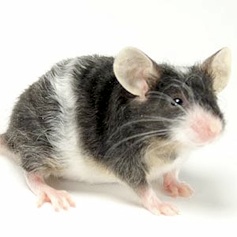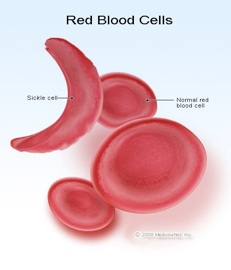Mutation

As discussed in the introduction, mutations are changes in the genetic code that lead to different traits arising. These mutations can be passed down genetically and either be lost or become fixed. Since mutation usually affects a single individual in a population, the initial fraction is small and the probability of fixation is thus also small (high probability of loss). However, in large populations even with a small initial fraction, it can take a long period of time for loss of a mutation to be complete. For example, in a population of 10,000 humans, the mean time to fixation or loss of a mutation from one individual is around 20 generations or 500 years!
Here are some examples of mutations in plants, animals and humans:

A mutation in these garden moss roses (shown in the left) has caused some of the flowers to grow orange rather than yellow. Photo credit: http://en.wikipedia.org/wiki/Mutation . On the right, a fairly common mutation in mice causes bands in the coat around the body. Photo credit: http://www.thefunmouse.com/varieties/marked.cfm

Finally, a common mutation in humans causes red blood cells to be shaped in a sickle pattern as shown above on the upper left. This mutation is known as sickle cell anemia. Photo credit: http://www.emedicinehealth.com/sickle_cell_crisis/article_em.htm

To connect the idea of mutations back to our discussion of DNA and proteins, here are some examples of how a mutation in the DNA can lead to a change in the protein:
-
1)A number of nucleotides not divisible by three is either inserted into or deleted from the DNA. This shifts the position of the codons being read to create amino acids and is known as a frameshift mutation. For example, if the original sequence is CCC CAG AGA (corresponding to amino acids proline, glutamine and arginine) and there is an insertion (in red) leading to the sequence CCG ACC AGA GA, the corresponding amino acids will change to proline, threonine and arginine and will shift which bases are in the codons in the rest of the RNA read after this sequence.
-
2)A nonsense mutation is a change of base at one point in the DNA that causes a stop signal where one shouldn’t be and halts the creation of a protein in the middle.
-
3)A missense mutation is a change of base at a point in the DNA that results in the substitution of a different amino acid than originally intended at some point in the protein. This can change or inhibit the function of the protein.
-
4)A neutral mutation is one leading to a substitution of a different amino acid than originally intended, but not to one that alters the function of the protein.
-
5)A silent mutation is one that does not lead to a change in the amino acid sequence of a protein.